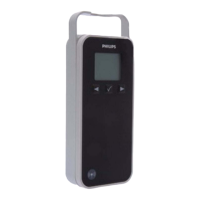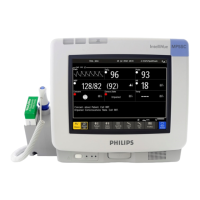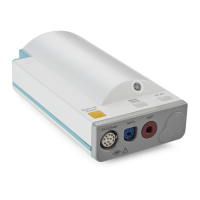3 Monitoring SpO2
36
Assessing a Suspicious SpO2 Reading
Traditionally, pulse rate from SpO
2
was compared with heart rate from ECG to confirm the validity of
the SpO
2
reading. With newer algorithms, such as FAST-SpO
2
, this is no longer a valid criteria because
the correct calculation of SpO
2
is not directly linked to the correct detection of each pulse.
When pulse rate is very low, or strong arrhythmia is present, the SpO
2
pulse rate may differ from the
heart rate calculated from ECG but this does not indicate an inaccurate SpO
2
value.
If you doubt the measured SpO
2
, use the signal quality indicator (if available) or, when used with a
patient monitor, the pleth wave and perfusion indicator on the monitor to assess the signal quality.
WARNING
With pulse oximetry, sensor movement, ambient light (especially strobe lights or flashing lights) or
electromagnetic interference can give unexpected intermittent readings when the sensor is not
attached. Especially bandage-type sensor designs are sensitive to minimal sensor movement that might
occur when the sensor is dangling.
Changing the Averaging Time
Depending on the monitor configuration, you may be able to change the averaging time for the SpO
2
values.
The averaging time represents the approximate time period used for the calculation. The exact
averaging time also depends on the signal conditions. The longer the averaging time, the longer the
time needed until the SpO
2
values reflect the physiological event. The same averaging is applied to all
numerical values: SpO
2
, pulse rate and Perfusion Index (only available at the patient monitor). Fast
averaging is useful for situations where an extremely fast measurement is required or few artifacts are
expected. Use slow averaging where you expect the number of artifacts to be relatively high.
1 In the SpO₂ menu, select Average.
2 Select the required averaging time from the list.
Understanding SpO2 Alarms
If you are using the SpO
2
Pod with an assigned patient monitor, you will see SpO
2
alarms and pulse
rate alarms (if configured) on the monitor.
There is a delay between a physiological event at the measurement site and the corresponding alarm at
the host system. This delay has two components:
• The general system delay time is the time between the occurrence of the physiological event and
when this event is represented by the displayed numerical values. This delay depends on the
algorithmic processing and the configured averaging time. The longer the averaging time
configured, the longer the time needed until the numerical values reflect the physiological event.
• The time between the displayed numerical values crossing an alarm limit and the alarm indication
on the monitor. This delay depends on the host system.
Refer to the Instructions for Use of the monitor for information about the SpO
2
and pulse rate alarms.

